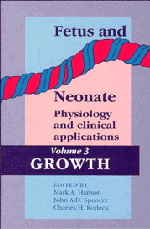Book contents
- Frontmatter
- Contents
- Preface to the series
- List of contributors
- Part I Physiology
- Part II Pathophysiology
- 6 Experimental restriction of fetal growth
- 7 Placental changes in fetal growth retardation
- 8 Human fetal blood gases, glucose, lactate and amino acids in IUGR
- 9 Glucose and fetal growth derangement
- 10 Fetal programming of human disease
- Part III Clinical applications
- Index
7 - Placental changes in fetal growth retardation
from Part II - Pathophysiology
Published online by Cambridge University Press: 04 August 2010
- Frontmatter
- Contents
- Preface to the series
- List of contributors
- Part I Physiology
- Part II Pathophysiology
- 6 Experimental restriction of fetal growth
- 7 Placental changes in fetal growth retardation
- 8 Human fetal blood gases, glucose, lactate and amino acids in IUGR
- 9 Glucose and fetal growth derangement
- 10 Fetal programming of human disease
- Part III Clinical applications
- Index
Summary
Introduction
Many factors, which may be maternal, fetal or maternal–fetal, may contribute, either singly or synchronously, to intrauterine fetal growth retardation (IUGR). Pathophysiological studies have concentrated on pre-eclampsia, with which IUGR is commonly associated. It is now apparent that ‘idiopathic’ IUGR, not associated with pre-eclampsia, shares much of the pathophysiology of pre-eclampsia, with hypoperfusion of the intervillous space as a feature. The underlying pathology has often been ascribed to ‘placental insufficiency’ or, more correctly, uteroplacental insufficiency. It is necessary, therefore, to review the morphological features of the maternal blood supply to the placenta in normal pregnancy before describing the features in pre-eclampsia and IUGR. It is useful also to understand the techniques that have been used for obtaining the maternal tissue and their limitations to underscore these studies. Finally, the pathology of the placenta in pre-eclampsia and in IUGR is described.
Sampling the uteroplacental vasculature
Placental bed biopsy
Early morphological studies of human placentation were based on the delivered placenta, on sporadic specimens from hysterectomy during pregnancy and on specimens obtained at autopsy following maternal death. Examination of the delivered placenta provided only an incomplete picture of the maternal side of the blood supply. The autopsy material was, thankfully, rare and often suffered from postmortem artefacts. Much use was therefore made of the Caesarean hysterectomy specimens, including specimens removed with the placenta in situ so as to preserve the relationship between the placenta and the placental bed.
- Type
- Chapter
- Information
- Fetus and Neonate: Physiology and Clinical Applications , pp. 177 - 200Publisher: Cambridge University PressPrint publication year: 1995
- 2
- Cited by



